An interview with US Navy Seal David Goggins
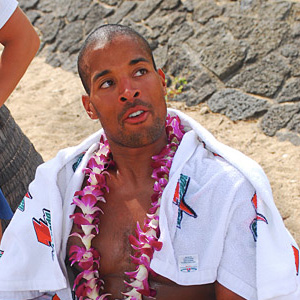
For a guy who says he does not enjoy the physical toll of running, United States Navy SEAL David Goggins sure does a good job of fooling those of us watching from the sidelines.
In 2001, he graduated from Basic Underwater Demolitions/SEAL (BUD/S) training with Class 235. In 2004, Goggins graduated from Army Ranger School with the distinction of enlisted "Top Honor Man." His life as a SEAL has led him to operational assignments with SEAL Team FIVE, based in Coronado, California, with multiple deployments to Afghanistan and Iraq. He has also served as a close quarters combat instructor and land warfare instructor.
In November 2005, Goggins received the tragic news of a helicopter crash in Afghanistan that was carrying six of his fellow SEALs who were killed in action. This devastating accident sparked action and he began to participate in extreme Ultra Running events to raise money for the families of his fallen comrades and to honor their warrior spirits.
As an Ultra Athlete, Goggins has completed in fourteen 100-plus-mile races. His first complete triathlon was the Ultraman World Championships in 2006 where he finished second place overall while using a rented bike without clipless pedals.
On the eve before the 30th anniversary Ironman Hawaii, Slowtwitch caught up with Petty Officer 1st Class Goggins and his wife Liza after bike check-in at the King K Hotel in Kailua-Kona.
David: I actually just got back from France doing Mont Blanc 100-mile race. It was probably the hardest 100-mile race in the world. Actually, 106-miles, 33,000-ft of climbing. I did that three weeks ago so my body hasn't quite recovered from that yet. It starts in France, goes into Italy into Switzerland and back into France so it makes a big circle around the base of Mt. Blanc. Very mountainous. I was ready for it, but the race itself breaks you down.
ST: You started running races in 05 and 06?
David: My first race was in November of 05. I'm not sure if it's a SEAL mentality, I can't speak for all the SEALs, but I know it's my mentality. I was pretty stupid about that. It's not arrogance on my part, but sometimes you think you can do things but I wasn't prepared for it. I was 280-lbs and running 20-minutes every other day and not really thinking about it too much. It's a very funny picture, but everybody thinks they can do more than what they can.
ST: What does that do to your body?
David: It destroyed my body. Luckily my wife is a nurse. At mile 70, everything in my body shut down. A 280-lb man isn't supposed to run that far. I broke almost all the metatarsals in my feet. I had stress fractures, shin splints, all my kidneys shutdown and I was urinating blood.
ST: Did stopping ever cross your mind?
David: No. Not at all. No.
Liza: When he started peeing blood, yeah. When I saw that his kidneys were failing, I thought he should stop and that there was a risk he could die, but he said no and that he wanted to keep going.
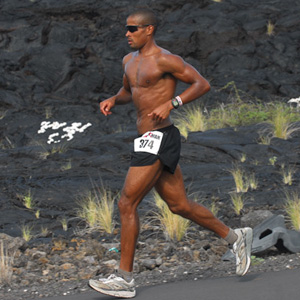
ST: You start your training runs in the wee hours of the AM?
David: Here's the thing. I don't like doing this. I don't like to run, but it's one of the ways I can find out who I am in life. I can't find out who David Goggins is by watching Sunday Night Football. I need to set the bar high and then try to meet it. The only way I can that is to do ridiculous things at the most ridiculous times. When I'm really tired and want to sleep, that's when I go out there and do it.
ST: And you (to Liza, David's wife), you don't mind it?
Liza: If he can run it, I can drive it.
ST: That (the driving) would be brutal.
David: It takes a very supportive wife.
ST: What did you think of Captain Duncan Smith’s idea to parachute and then race?
David: I was a support guy out here last year. I thought it was a cool idea but I never thought it would happen. I just thought it was a bunch of guys talking.
Now that it's here, there are a lot of logistics involved in this. There is a lot of timing. You have to jump out right before the race and get back to shore, make sure timing chips are working, making sure all of your gear is on. Then to get back to the starting line and then start going. I think it's a pretty neat idea, all in all, it's a pretty neat idea.
ST: Is the jump more practice than the actual race?
David: I'm not that worried about the race. It's a very hard race but I'm more concerned about the jump. Being safe and everybody being safe and everything going right. You can lose your life in a triathlon but you need to make sure you have thought about jumping out of an airplane before you can think about a 2.4-mile swim.
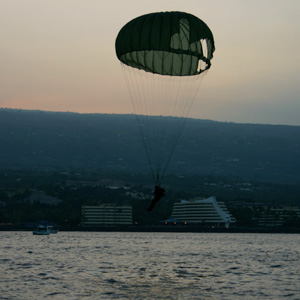
ST: What logistics are going into your day tomorrow? When does your day begin?
David: My day will start at 4:00AM. Actually, I'll get up at 3:00AM and then from there I'll make sure I have everything for the jump including: my fins, my uniform, my booties and my jump helmet. I'll make sure everything is good to go. From there, I'll come downstairs and get my body markings on very quick.
Myself and Keith Davids will jump in a car and go to the airport, get our parachutes checked, make sure that's all good, make sure our fins are right, hop in the airplane, do a take off, and then jump out. From there, the logistics of making sure the boats are there to pick us up on time and making sure we drop out of the bird right where we need to drop. If things don't go exactly right, it could be a pretty long day. If things go right like we've practiced, it should all be good.
ST: Have you completed any practice jumps this week?
David: I actually didn't jump today. We were out there watching the jump so we were on the ground to see how everything should look an getting a different angle. We wanted to see how long it would take for everybody to get in back to pier after the jump.
ST: How does an Ironman compare to the other events you do?
David: I'm not putting the Ironman down by any means, it's just that I'm conditioned to go longer. This is a long race and these guys can go fast, that's the amazing thing about these athletes. They can redline, max heart rate, for 8 and 9 hours. I'm not capable of doing that.
ST: Is this race like a sprint for you?
David: This is a sprint race, but I'm not capable of sprinting. I'm a guy who can go 48 hours of non-stop running but at 140 heart rate.
ST: Will you do another workout after the race finish?
David: That's kind of my mentality about the whole thing. I'll see what happens. I'll definitely do something else after the race is over. Once the Ironman is over, I will do some more working out but it will be on my own time after everything is shut down.
ST: How do you prepare for the jump aspect of your day?
David: We have a whole bunch of different A, B, C and D plans. Say tomorrow, we get up and it's raining. Then the jump is canceled and we go right to the starting line and are normal racers like everyone else. Say something happens where everything goes right and we get out to the landing strip where the bird is at and we're going to load it but something is wrong with the bird. We have a backup plan for that to get in the cars and drive back. If something happens where we're up there and ready to jump out but something happens where we can't jump, then our plan C is to fly back to the landing strip, get our equipment and get back to the start for the race. We have a whole bunch of plans in case any one of those things should happen. In the military, you learn that one plan is not enough, two plans is not enough, three plans…maybe.
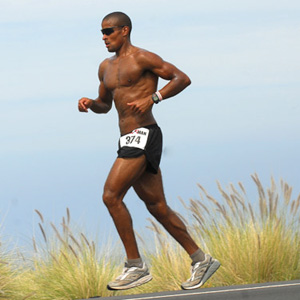
ST: What is your transition from parachute uniform to racing uniform going to look like?
David: Once we land and jump into the boat, the boat will race us to shore, and we'll get out and get dressed. If I wear my speedsuit under the parachute equipment, it will get torn. The jump is kind of violent.
ST: How high up will you be when you jump?
David: It depends tomorrow how the clouds and weather are. It could be as high as 12,500-feet or it could be as low as 2,000-feet.
ST: What will the rest of your racing season be like?
David: I thought about coming back out for Ultraman in November but I'm going to Oahu in January for the Hurt 100. It's a 100-mile trail race out there and is probably one of the hardest trail races in America. It's technical, lots of climbing and rooty. We'll see what happens.
ST: What are the other competitors like in the Ultraman and ultra running races?
David: You know, those races are much different than Ironman. There are maybe 100 other competitors out there racing, the finish line may have four or five people standing at it, you may get an award like a belt buckle but you will likely get nothing at all. There is no hoop-la, there is a pasta dinner, and stuff like that.
ST: Do you like that about Ultra events?
David: I do. It's not that I'm shy, but I just don't need anyone shouting my name when I cross the finish line.
ST: Will being an Ironman mean something to you? Some racers have trained and worked towards that moment their entire lives. Having served our country in war, how do you put that in perspective?
David: For me triathlon and Ironman is a great experience. To be here, with all these people, to see people in wheelchairs and with no legs competing, that's inspirational to me. It's going to be a long and hard day for me and a whole lot of people, but it's really just a good training day for me to use towards other much longer races in the near future.
ST: What is your SEAL career looking like right now?
David: Right now I'm still active and have been in the military for 13 years. I've been a SEAL for almost 9 of those years. As of right now I have a couple more years left in the Navy and I'll probably extend at that time. The Navy is a great opportunity for me and my family. If not, who knows, maybe I'll come back and be a professional triathlete.
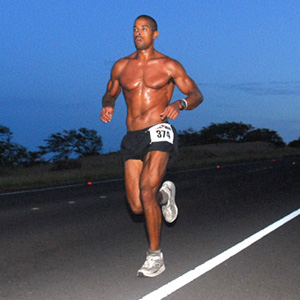
ST: How do you balance training for these endurance events with your professional SEAL career where your team is counting on you?
David: For me, when I'm going through my team workouts, it's hard on the body, because going through the normal SEAL training is really hard on the body. But, I'm the kind of person who believes there are 24 hours in the day so if you miss training, it's all on you. You may miss an hour or two of sleep but then you can get in an hour or two of training.
I wake up at 3 o'clock in the morning because I have to work by a certain time. I judge my workouts so they fit around my work schedule. I have to be to work at 7 o'clock so what happens is I wake up with enough time to get in my morning run, then ride my bike into work – a 25-mile ride one way. To get all that stuff in I need at least a four hour window.
When I get to work, the worse case scenario is I can't do anything else that day. No run at lunch time, but I know that when work is over I'm going to ride my bike back home.
ST: What does work consist of for you?
David: Right now I'm more at the instructional level. I'm doing instruction type duties. I'm going around and doing a lot of mentoring for younger kids. I'm flying a lot now, going around and going to schools and telling people what it's like to be, not only a Navy SEAL, but to be healthy in life. With obesity in American right now, I'm getting out there and expressing to these kids what it means to live a healthy lifestyle.
ST: Is there a beneficiary you are working with?
David: For me right now, I'm raising money for all Special Operation units and branches. If you're a Ranger, if you're a Green Beret, if you're a SEAL, I'm just trying to raise money for your family. Being that I went through Ranger school (Ed note: Goggins graduated Ranger school as the Honor Man) and I was in the Air Force and now I'm a SEAL, I've been through all of them and I want to give back.
As far as the obesity thing goes, I'm hoping that maybe someone hears my story about weighing 280 pounds and now I weigh 185, and maybe that will touch someone's life for them to think if that guy can do it, maybe I can too.
On Saturday, October 11th, Petty Officer David Goggins, Commander Keith Davids, and Captain Duncan Smith parachuted out of the C-130 (bird) and into Kailua-Kona Bay only moments before the professional men and women's race began.
All three men landed successfully and completed the first ever transition 0 (parachute to swim) and went on to complete the 30th anniversary Ironman Hawaii. Although they competed separately, Goggins and Davids completed the event in 11 hours and 24 minutes, and crossed the finish line together. Smith completed the parachute, then established a perimeter to ensure the other two men completed their jumps safely and successfully.
To learn more about Special Operations Warrior Foundation, or to make a donation for the children of military Special Operations personnel who were killed on a mission or training accident, please visit: specialops.org. For more information on Goggins, go to his personal website: the100mileman.com.
All David Goggins running images © Timothy Carlson (Ultraman 06)

